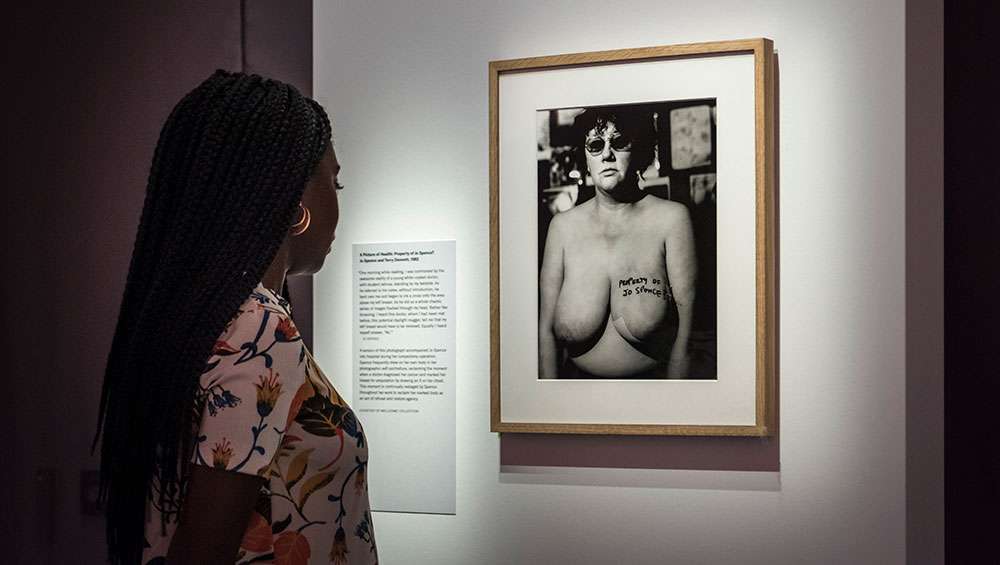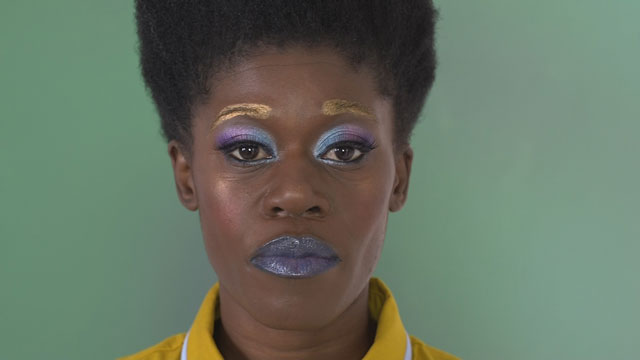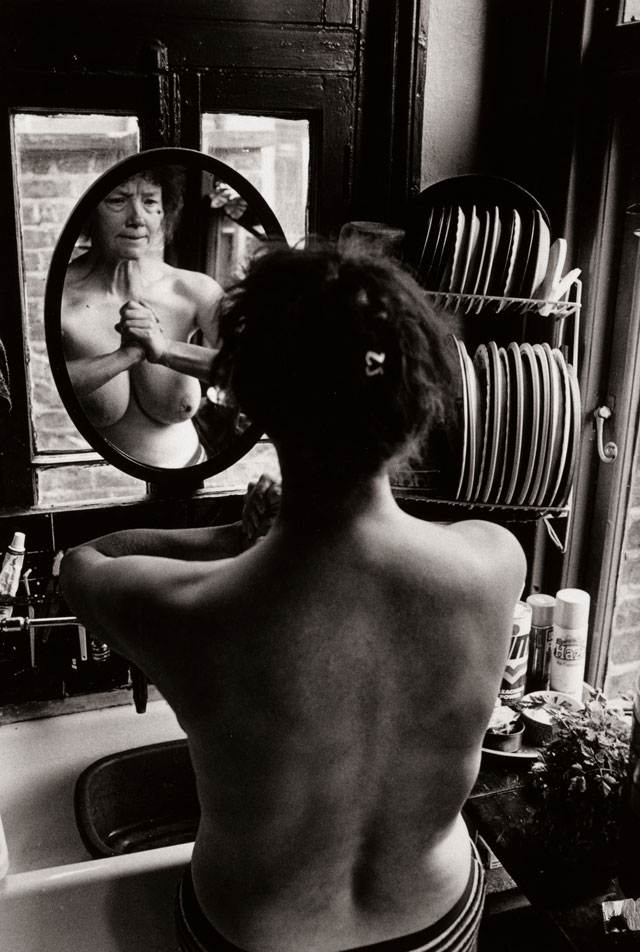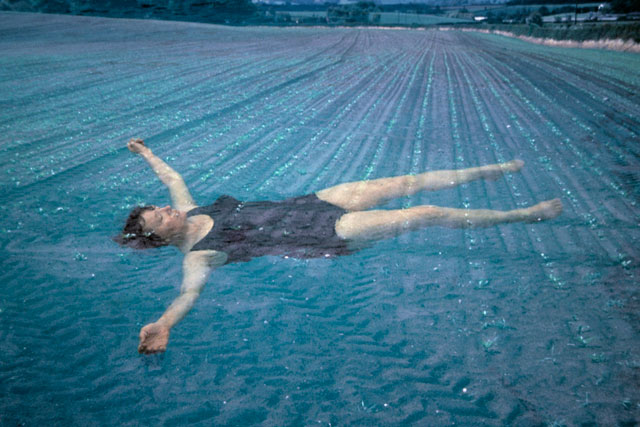
Jo Spence and Oreet Ashery: Misbehaving Bodies. Installation shots. Photo: Thomas Farnetti, Courtesy Wellcome Collection.
Wellcome Collection, London
30 May 2019 – 26 January 2020
by BETH WILLIAMSON
The work of Jo Spence (1934-92) and Oreet Ashery (b1966) is both tender and uncompromising. The misbehaving bodies pictured in this exhibition may, at times, present difficult viewing, but it remains a privilege to share in their stories. Through photography, Spence explored her own lived experience of illness, working closely with her long-time collaborator Terry Dennett. Ashery, meanwhile, explores the representation of death and life-limiting illness through a 12-chapter digital film series, Revisiting Genesis (2016), a digital fable that intertwines real-life testimony with fiction.

Revisiting Genesis, Oreet Ashery. video still. Courtesy of the artist.
One of the central questions for the exhibition’s curators is: “How does illness disrupt and shape our identity?” Bringing works by Spence and Ashery into dialogue presents an opportunity to explore that question in a particularly raw and vital manner. The curators, Bárbara Rodríguez Muñoz and George Vasey, should be commended for their sensitive handling of this incredibly poignant material. Collaboration and co-creation were important for Spence in reclaiming her illness and how she chose to live with it. One key strategy for Spence in living with cancer was her experience of phototherapy, a process of co-counselling using photography and drama techniques. Here, Spence worked with Rosy Martin to act out episodes of her life, including her cancer diagnosis, confronting repressed feelings and creating a series of photographs between 1984 and 1986 that document her exploration of traumatic episodes.
.jpg)
The Picture of Health, Jo Spence in collaboration with Rosy Martin, Maggie Murray and Terry Dennet, 1982. Copyright The Jo Spence Memorial Archive, Ryerson University, Courtesy MACBA Collection.
This was just one of the ways that Spence reclaimed her illness and her body from the medical profession. She investigated raw-food diets and alternative therapies in her quest for knowledge and understanding. In her autobiography, she noted: “I’m not saying that because you have other knowledge you can rid yourself of the disease, I am saying that armed with new knowledge you are able to make choices to act rather than be acted upon”.1 It is that sense of ownership and agency that is so clearly articulated in all Spence’s work. In The Final Project [‘End Picture’ Floating] (1991-92), made following her leukaemia diagnosis in 1991, a photograph of Spence floating in water with arms outstretched remains powerful. As a counterpoint to her earlier more confrontational images, its calm contemplative mood is all the more arresting.
.jpg)
Jo Spence and Oreet Ashery: Misbehaving Bodies. Installation view. Photo: Thomas Farnetti, Courtesy Wellcome Collection.
Ashery’s film Revisiting Genesis (2016) is freely available online, but the opportunity to view chapters in a gallery setting alongside work by Spence makes for a rather different understanding of the work. The exhibition at the Wellcome Collection shows the chapters grouped together in a number of carpeted spaces draped in swathes of material in reds and pinks, complete with low soft furnishings and giant teddies. These are the sort of comfortable spaces in which we feel shielded from the outside world and able to face our inner vulnerabilities and fears, including illness and death. That is precisely what is required when viewing the Revisiting Genesis series.
.jpg)
The Picture of Health, Jo Spence in collaboration with Rosy Martin, Maggie Murray and Terry Dennet, 1982. Copyright The Jo Spence Memorial Archive, Ryerson University, Courtesy MACBA Collection.
In the merging of fiction with real-life testimony, we encounter the fictional artist Genesis, who is dying, and meet the real-life artist Martin O’Brien, who lives with cystic fibrosis and plays the character Bambi in Ashery’s film. Among the film’s multiple narratives are the digital legacies we leave behind us. A fictional company provides online emotional wills, life-extending avatars, augmented gravestones and prerecorded video messages to be sent to loved ones on important days. As Ashery explains in the exhibition booklet: “Technology is changing rapidly and promises all kinds of things. It suggests that we can penetrate the afterlife because it has extracted everything possible from our bodies through capitalism while we were alive”.2 The way digital technologies are used in this fictional futuristic narrative might be new, but the fundamental concern is with human beings who want to be remembered.

The Picture of Health, Jo Spence in collaboration with Rosy Martin, Maggie Murray and Terry Dennet, 1982. Copyright The Jo Spence Memorial Archive, Ryerson University, Courtesy MACBA Collection.
What this exhibition does is confront us with illness and mortality and force us to consider how we deal with these difficult facts of life. In her important book Regarding the Paint of Others (2003), Susan Sontag reflected: “It seems exploitative to look at harrowing photographs of other people’s pain in an art gallery … Up to a point, the weight and seriousness of such photographs survive better in a book, when one can look privately, linger over the pictures, without talking. Still, at some point the book will be closed. The strong emotion will become a transient one.”3 Perhaps one of the strengths of this exhibition is that the strong emotions it elicits do linger, long after departing the gallery. This is partly to do with the way the exhibition has been curated with detailed, almost painstaking reading required for much of Spence’s work. Similarly, there are intimate comfortable spaces in which to view Ashery’s film – these feel like safe spaces in which to explore questions of identity. At the same time, other chapters of the film showing in adjacent spaces can be overheard, eavesdropped on rather like the personal conversations often overheard in hospital wards.

Jo Spence. The Final Project ['End Picture' Floating]. Copyright The Jo Spence Memorial Archive, Ryerson University. Courtesy Estate Jo Spence, Richard Saltoun Gallery.
The enduring impact of this exhibition is also to do with the nature of the photographic image itself. In her reflections On Photography (1990) Susan Sontag noted that: “All photographs are ‘memento mori’. To take a photograph is to participate in another person’s (or thing’s) mortality, vulnerability, mutability.”4 The take away, or memento, from this exhibition is a better understanding of other people at some of their most vulnerable moments. With understanding, comes empathy. It has to be hoped so, at least.
From 2 October 2019, Ashery’s new film commission Dying Under Your Eyes will be part of the exhibition. The film explores the sudden death of Ashery's elderly father and end-of-life care.
References
1. Putting Myself in the Picture: A Political, Personal and Photographic Autobiography by Jo Spence, published by Camden Press, 1986, page 188.
2. Oreet Ashery in Jo Spence and Oreet Ashery: Misbehaving Bodies exhibition booklet, published by Wellcome Collection, 2019, unpaginated.
3. Regarding the Pain of Others by Susan Sontag, published by Picador, 2003, page 119.
4. On Photography by Susan Sontag, published by Penguin, 1990, page 15.